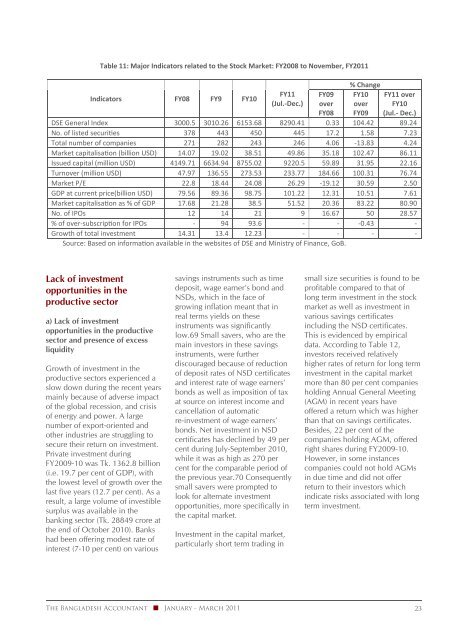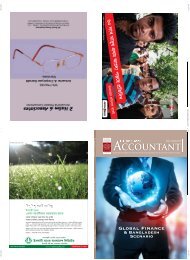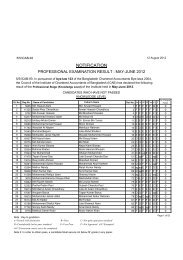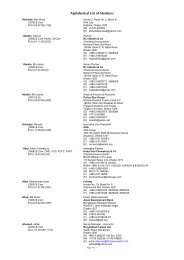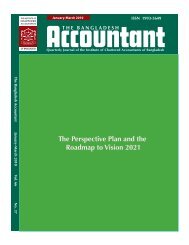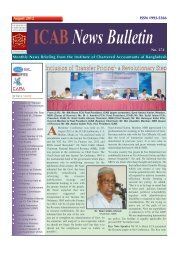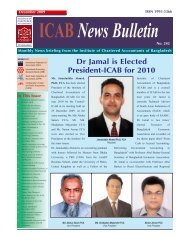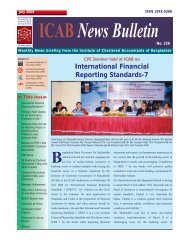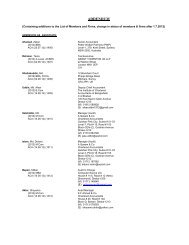Forma # 1.ai - ICAB
Forma # 1.ai - ICAB
Forma # 1.ai - ICAB
You also want an ePaper? Increase the reach of your titles
YUMPU automatically turns print PDFs into web optimized ePapers that Google loves.
Table 11: Major Indicators related to the Stock Market: FY2008 to November, FY2011<br />
Indicators FY08 FY9 FY10<br />
FY11<br />
(Jul. Dec.)<br />
FY09<br />
over<br />
FY08<br />
% Change<br />
FY10 FY11 over<br />
over FY10<br />
FY09 (Jul. Dec.)<br />
DSE General Index 3000.5 3010.26 6153.68 8290.41 0.33 104.42 89.24<br />
No. of listed securies 378 443 450 445 17.2 1.58 7.23<br />
Total number of companies 271 282 243 246 4.06 13.83 4.24<br />
Market capitalisaon (billion USD) 14.07 19.02 38.51 49.86 35.18 102.47 86.11<br />
Issued capital (million USD) 4149.71 6634.94 8755.02 9220.5 59.89 31.95 22.16<br />
Turnover (million USD) 47.97 136.55 273.53 233.77 184.66 100.31 76.74<br />
Market P/E 22.8 18.44 24.08 26.29 19.12 30.59 2.50<br />
GDP at current price(billion USD) 79.56 89.36 98.75 101.22 12.31 10.51 7.61<br />
Market capitalisaon as % of GDP 17.68 21.28 38.5 51.52 20.36 83.22 80.90<br />
No.ofIPOs 12 14 21 9 16.67 50 28.57<br />
%ofoversubscripon for IPOs 94 93.6 0.43<br />
Growth of total investment 14.31 13.4 12.23<br />
Source: Based on informaon available in the websites of DSE and Ministry of Finance, GoB.<br />
Lack of investment<br />
opportunities in the<br />
productive sector<br />
a) Lack of investment<br />
opportunities in the productive<br />
sector and presence of excess<br />
liquidity<br />
Growth of investment in the<br />
productive sectors experienced a<br />
slow down during the recent years<br />
mainly because of adverse impact<br />
of the global recession, and crisis<br />
of energy and power. A large<br />
number of export‐oriented and<br />
other industries are struggling to<br />
secure their return on investment.<br />
Private investment during<br />
FY2009‐10 was Tk. 1362.8 billion<br />
(i.e. 19.7 per cent of GDP), with<br />
the lowest level of growth over the<br />
last five years (12.7 per cent). As a<br />
result, a large volume of investible<br />
surplus was available in the<br />
banking sector (Tk. 28849 crore at<br />
the end of October 2010). Banks<br />
had been offering modest rate of<br />
interest (7‐10 per cent) on various<br />
savings instruments such as time<br />
deposit, wage earner’s bond and<br />
NSDs, which in the face of<br />
growing inflation meant that in<br />
real terms yields on these<br />
instruments was significantly<br />
low.69 Small savers, who are the<br />
main investors in these savings<br />
instruments, were further<br />
discouraged because of reduction<br />
of deposit rates of NSD certificates<br />
and interest rate of wage earners’<br />
bonds as well as imposition of tax<br />
at source on interest income and<br />
cancellation of automatic<br />
re‐investment of wage earners’<br />
bonds. Net investment in NSD<br />
certificates has declined by 49 per<br />
cent during July‐September 2010,<br />
while it was as high as 270 per<br />
cent for the comparable period of<br />
the previous year.70 Consequently<br />
small savers were prompted to<br />
look for alternate investment<br />
opportunities, more specifically in<br />
the capital market.<br />
Investment in the capital market,<br />
particularly short term trading in<br />
small size securities is found to be<br />
profitable compared to that of<br />
long term investment in the stock<br />
market as well as investment in<br />
various savings certificates<br />
including the NSD certificates.<br />
This is evidenced by empirical<br />
data. According to Table 12,<br />
investors received relatively<br />
higher rates of return for long term<br />
investment in the capital market<br />
more than 80 per cent companies<br />
holding Annual General Meeting<br />
(AGM) in recent years have<br />
offered a return which was higher<br />
than that on savings certificates.<br />
Besides, 22 per cent of the<br />
companies holding AGM, offered<br />
right shares during FY2009‐10.<br />
However, in some instances<br />
companies could not hold AGMs<br />
in due time and did not offer<br />
return to their investors which<br />
indicate risks associated with long<br />
term investment.<br />
The Bangladesh Accountant January - March 2011 23


